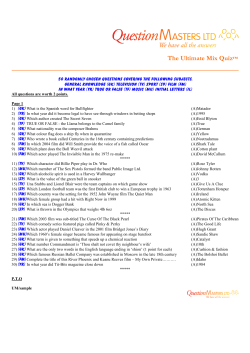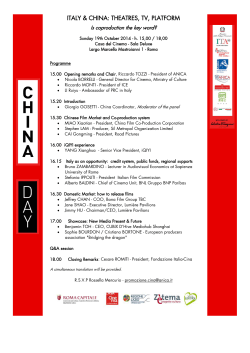
a film by Marijn Kraak Reimer van Tuinen
a film by Marijn Kraak Reimer van Tuinen Karel Poortman www.authenticized.nl logline With their exotic appearance and unique way of life, the indigenous Himba people of Namibia are a huge attraction for tourists, photographers and filmmakers. But authenticity comes at a price. synopsis An increasing number of tourists, photographers, filmmakers and television crews travel to the Himba people in Namibia in search of genuine experiences and spectacular images. With their exotic appearance and traditional way of life, the Himba satisfy that need – on request and at the right price. As they become economically dependent on their own representation, the Himba now have to live up to their image, while simultaneously trying to preserve a culture in transition. In the midst of this industry of images, Authenticized observes the groups on every side of the lens: framing, posing, paying and performing. authenticity The notion of authenticity has been widespread in societies all over the world throughout history, but especially in times of social and economical disquiet its appeal seems to increase. A society that is struggling to define its own place in the world, looks for self-affirmation in things that are considered to hold a universal, historical or national truth – ideas, experiences and images that are authentic. In present times we find an increasing demand for authenticity in our use of, interaction with and ideas about such diverse domains of our culture as technology, politics, work, leisure and media. It's in the pictures we upload through Instagram, in the vintage furniture we buy at excessive prices and in the preparation of our daily food. It's in the renewed interest in work that involves traditional craftsmanship and in the popularity of movies that are based 'on true events'. Authenticity is trending, in both the public and the private – and on TV. Television nowadays offers a multitude of reality soaps and travel programmes about exotic and secluded places and communities. Celebrities, common people and TV personalities visit primitive tribes in Africa or Asia, take part in ancient rituals and survival contests in the most remote areas of the world or live a few days with poor people to experience their hardship. The authentic experience has proven to be a lucrative market for the tourist industry as well. Travel agencies compete for the most exotic and profound holiday experiences, while the traditional beaches and museums are gradually being replaced by hazardous slums, desolate monasteries, mythical springs and primitive desert villages. Television programmes and tourist destinations that exploit the authentic experience often focus on a culture clash between opposing lifestyles. Generally they put the affluence, materialism and comfort of 'modern' life in contrast with the genuine 'simplicity' of local communities that are still supposedly unspoiled by modernity. Primitivism, traditionalism and in some cases even poverty thus become signifiers of authenticity for the First World spectators that seek refuge from the detriments of their advanced civilisation with its hi-tech bureaucracy, rat-race economy, indifferent consumerism and depleted environment. This demand for authenticity, and its particular embodiment in fantasies about the primitive and the tribal, finds one of its most physical expressions in the north-western part of Namibia, called the Kunene region, where the Himba people live. This region is one of the least populated areas in Namibia, with a population density of one person for every 2 km². The main settlement in the Kunene region is Opuwo, a city of about 15,000 inhabitants, situated 720 km north from the capital Windhoek. The Himba are an ethnic group of about 40,000, mostly semi-nomadic, pastoral people, that breed cattle and goats. They speak OtjiHerero. Because of their harsh living environment, their relative seclusion from outside influences and their socio-political isolation within Namibia, the Himba have managed to maintain much of their traditional lifestyle. They live under a tribal structure based on bilateral descent, which is found among only a few groups in the world. They live in clay sheds. Traditionally they wear little clothing and both the men and the women go topless and wear skirts or loincloths made of animal skins. The women cover themselves with otjize, a mixture of butter fat and ochre, which gives their skins a reddish tinge. Himba boys and girls are circumcised before puberty. Allegedly, on their eleventh birthday the front teeth of the girls are knocked out and men are said to kill cattle only by hand. In short, the appearance and customs of the Himba people cater perfectly to the cultural demand for authenticity. With their presumed primitive way of living, the Himba meet with the romantic notion of a world that isn't yet corrupted by modernity, technology and materialism. As such, the Himba seem to live up to the image that tourists, photographers and filmmakers are looking for. Consequently, since the independence of Namibia in 1990 and the following increased accessibility of the area, the Kunene region has become a prime site for international tourism. In recent years the Himba have been appearing frequently on television shows and in documentaries from all over the world. Tourism and television are now so ubiquitous in the region that for many Himba it has become a source of income. Money is earned from tourists and television crews who visit the compounds, and an increasing number of Himba have started to work as tour guides, interpreters, location scouts or production assistants, have set up camp sites, lodges and luxury resorts for tourists or are providing so-called Himba Tours. At the same time, the presence of such large numbers of tourists, photographers and filmmakers means a violation of the very same authenticity those tourists and media professionals come looking for. Precisely those aspects of modern life that tourists wish temporarily to escape from, like smartphones, alcohol abuse and profit-making, are entering the daily lives of the Himba. As they have become to a large extent economically dependent on their own representations, the Himba now face the difficulty of living up to the primitive image that is expected of them, while simultaneously seeing their traditional ways of life heavily affected by the arrival of foreign visitors and media. As a consequence, the Himba have to cultivate their own authenticity. And so the Himba find themselves part of a true, socioeconomic industry of authenticity, in which tourists, local tour guides, professional photographers, television crews, camp site owners, municipal officials, film commission representatives, minority advocates and human rights lawyers all play their part in creating, recording, monitoring, legitimising and selling authenticity. Fundamental to this industry is the paradox that can be found in many places all over the world: that for the Himba authenticating their own culture now means cultivating their own authenticity. research context "This way you'll never get sloppy tits again!" With these words a Dutch middleaged woman tries to persuade a member of a local African tribe to wear a bra that is white as chalk. The scene comes from the Dutch reality soap Greetings from the Bush (Groeten uit de Rimboe, 2005). In the show Dutch families were being followed during their stay with the Himba people – "one of the last authentic tribes in Africa". The Dutch had to try to adapt to the allegedly primitive living conditions of the tribe. Greetings from the Bush is part of an international trend of television shows that focus on cultural differences. In the Netherlands shows like Holy Shit, Hollandse Krijgers, Kluners uit Kenia, Hier Slapen Jullie, Britt en Ymke en het Mysterie van… and, most recently, Welkom bij de Kamara’s have been aired to popular acclaim. In Belgium programmes like Toast Kannibaal, Allez Allez Zimbabwe and Belgen in de Rimboe have been aired. In the UK Tribe, Tribal Wives, Meet the Natives, Fat Men Can't Hunt and Last Man Standing were broadcast and the Germans could watch Wie die Wilden, Wild Girls: Auf High Heels durch Afrika and Reality Queens auf Safari. Obviously, culture shocks produce high ratings. In 2007 cultural anthropologist Marijn Kraak conducted field research in Namibia in order to map the production process of Greetings from the Bush and the public and academic debates surrounding the series. Kraak's research shows how the cultural differences in Greetings from the Bush were exaggerated and even staged. In the programme, the Himba were portrayed as a primitive tribe living in isolated conditions, untouched by modernity, thereby reinforcing stereotypical images of 'the African' as being exotic, obsolete and primitive. In the Netherlands Greetings from the Bush provoked a public debate that centered on the question whether or not the Himba had been exploited. Kraak spoke with the participating Himba and found out that they feel both content and disappointed about their participation: they did make money from the series and got the opportunity to make a trip to the Netherlands. At the same time, however, they were dissatisfied about the amount of money they were paid, the absence of contracts and the false promises that were made.!Also, they felt strongly about not having been shown the final result, since they hadn't got a clue, and still don't know, what they exactly participated in. Despite these disparities the Himba can't be seen as ignorant victims of a visual culture dominated by the West. They are aware of the appeal of their culture and actively play along with the image that foreigners wish to see, in order to make money from it. As such the Himba are turning into an icon of authentic indigenous peoples and are gradually becoming a multifunctional, visual 'product', which can be applied globally to various purposes. Since her research in 2007, Kraak returned to Namibia several times, getting more and more fascinated about the increasing number of foreign visitors in the area. Film applications are submitted to the Namibia Film Commission on a weekly basis, including similarly scripted series as Greetings from the Bush, as well as many other film and television formats. Clearly, Greetings from the Bush is not an isolated example, but seems to be part of a larger tendency reflecting the appeal of Namibia and its inhabitants to television and film makers. Kraak's research included interviewing Himba who participated in foreign film productions, filmmakers working in the Kunene area and representatives from the Namibia Film Commission and the Legal Assistance Center, an organization that focusses on minorities' rights in Namibia. Kraak also organized group discussions about framing and cultural representation with students from The College of the Arts in Windhoek. director biographies Marijn Kraak is a researcher, cultural anthropologist and author of 'Greetings from the Ovahimba. An investigation of the production process of and the opinions about the reality shows Greetings from the Jungle and Greetings Back' (Aksant, 2010). Reimer van Tuinen is a filmmaker and co-owner of Zuis Film. He worked previously as a curator at the Centre for Culture and Politics De Balie in Amsterdam. Karel Poortman is a filmmaker and co-owner of Zuis Film. Previously he worked as video specialist for Canon Europe. Zuis Film is a production company based in Amsterdam. Founded in 2001 by Karel Poortman and Neeltje Pavicic-van der Haak, Zuis Film produces commissioned and independent work. Authenticized is the first feature-length documentary by Zuis Film. A second documentary feature is currently in post-production: A School for My Daughter follows the well-known Dutch entrepreneur Maurice de Hond in his efforts to set up the first so-called 'Steve Jobs School' in the Netherlands. Directed by Neeltje Pavicic-van der Haak, with camerawork by Karel Poortman. credits original title country of production year of production running time original language subtitles screening format Authenticized The Netherlands 2013 100 min. television edit of 60 min. available English | OtjiHerero English harddisk | DCP directed by produced by Marijn Kraak, Reimer van Tuinen, Karel Poortman Zuis Film research & script camera montage music Marijn Kraak Karel Poortman Reimer van Tuinen Reinout Verbeek additional camera Ben Mberimunako Tjiposa Karongerisa Ngombe Tjimanya Kapika Komumuvanda Tjindunda Veryonga Tjirambi Uoviyeni Tjiuuyu Tjikukae Tjiuuyu translations Kapei Barnabas Tjindunda Marieke van Ommeren Raoul Köhler Sacha Naod special thanks to Jimmy Elia Tolu Laura Köhler Reinoud Degelink Authenticized has been financed by the filmmakers themselves, partly through crowdfunding. featuring as the tour guides Jimmy Elia Tolu Kapei Barnabas Tjindunda Konsa Tjiposa Anita Kavezuu Tjambiru Uvatera Ngombe Michael Uatiza Hepute as the Himba Aitiraike Tjirambi Kaviruru Kapika Komumuvanda Tjindunda Uvaserwa Kapika as the professionals Wania Tony Figueira Kim Man-Tae Lim Jong-Myung Choi Sam-Kyu as the tourists Django from Japan Sergio & Katherine from Italy and the UK Pierre & Robert from Switzerland Nuria & Xavier from Spain Michael, Alissa, Greg & Wesley from the USA as the bureaucrats Tjinezuma Kavari HIPO Hizetjitwa Indigenous Peoples Organization Willem Odendaal Legal Assistance Centre Namibia Vickson Hangula Namibia Film Commission Ted Scott Namibian Broadcasting Corporation Patrick Tjiuree Mumbuu Technical Committee Opuwo Cultural Centre Koos Verwey Epupa Falls Lodge and Campsite contact Zuis Film Tweede Jan Steenstraat 55 1074 CK Amsterdam The Netherlands +31 6 4542 4636 productie@zuis.nl www.zuis.nl contact for distribution | sales | publicity Karel Poortman karel@zuis.nl +31 6 4542 4636 contact for the directors Marijn Kraak marijnkraak@yahoo.com +31 6 1684 8127 www.vimeo.com/zuis www.facebook.com/zuisfilm Reimer van Tuinen reimer@zuis.nl +31 6 4526 4722
© Copyright 2025









